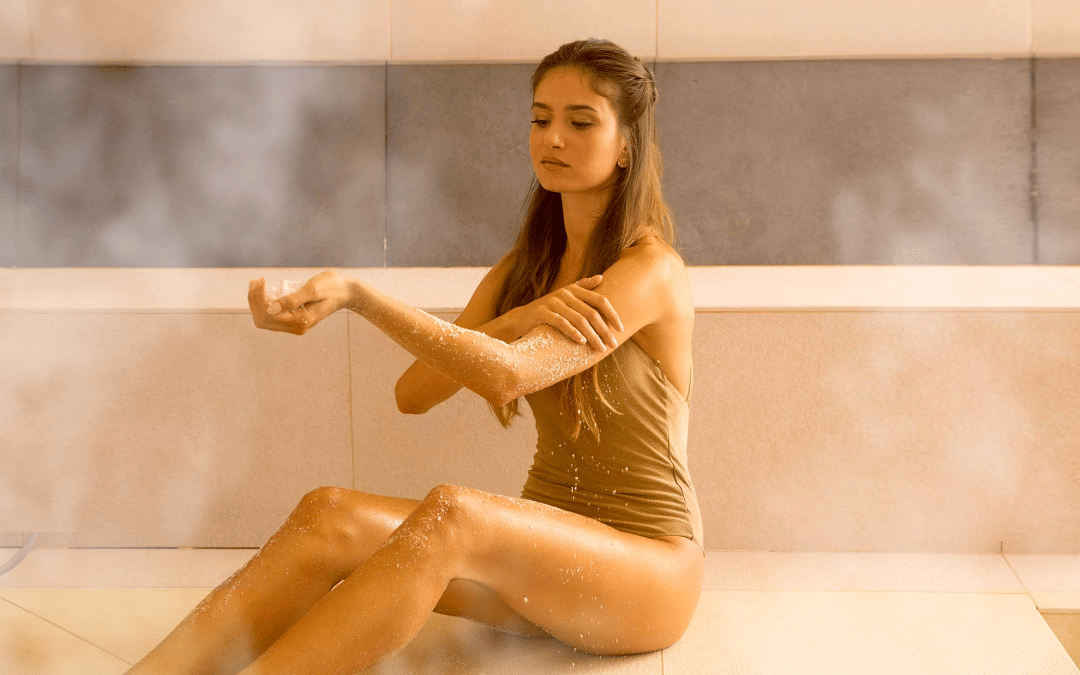It is a treatment used to exfoliate the most superficial layer of the skin. Its application helps to make the skin smooth, soft and radiant.
The scrub is a treatment indicated for regenerating tissue and exfoliating the skin. The term scrub literally means "torub, scrub," in fact in the composition of scrub there are particles that when applied and massaged, perform a mechanical-type exfoliating action.
The scrub consists of two parts: a creamy or liquid one and an exfoliating one. The latter is usually composed of granular substances, small spheres or powders. The exfoliating particles may be of vegetable origin (pulverized fruit stones, brown sugar, almond or oat flour, coconut), mineral origin (salt, silicon, kaolin), or consist of plastic microspheres.
The liquid or creamy part can also consist of natural ingredients such as vegetable oil (almond, coconut, olive), honey or yogurt.
It can also be made more fragrant or act on certain skin needs by enriching it with other ingredients such as essential oils, spices, flowers, cocoa or coffee.
This treatment accelerates the skin's natural renewal process and allows it to eliminate impurities and dead cells that are deposited on the skin.
After scrub, the skin regains its natural radiance, is silkier, smoother, brighter and free of impurities.
Regularly devoting oneself to exfoliation helps keep the skin revitalized and smooth.
How to make the scrub?
The best time of day to have a treatment with scrub is in the evening, so that the skin, during the night, can restore its balance. In addition, immediately after application, exposure to ultraviolet rays, whether artificial or natural, should be avoided.
The scrub is most effective if the skin is properly prepared. Ideally, this should be done after a session in sauna or steam room. In fact, the heat, especially moist heat such as that of the steam bath, opens the pores of the skin and softens it. Otherwise, it is recommended to take a shower and apply it to the skin while still moist.
At the end of the treatment, it is a good idea to rinse the body thoroughly with lukewarm water, making sure to remove any remaining grains. A cream, oil or fluid milk should always be applied after scrub to rehydrate the skin.
There are two main types of scrub: for the body (more vigorous and exfoliating) and for the face (more gentle).
SCRUB BODY
Body scrub should be applied to wet or damp skin and massaged in small circular motions from the bottom to the top, from the extremities to the center of the body.
We must always pay attention to the area we are treating, if it is more sensitive we must apply less pressure while trying to be gentle.
Absolutely to be avoided are recently shaved areas, which would risk irritation.
In parts such as the knees, elbows and heels instead we can apply a firmer massage.
SCRUB FACE
Some scrub are specially formulated for the delicate skin of the face. When applying scrub we try to massage the product in light, circular motions so as not to stress the skin and avoid irritation.
Areas to avoid are undoubtedly the eye area and lip area although recently special scrub have been created for lips, with a creamy texture that combines nourishment with exfoliation.
Making a scrub before a targeted treatment, such as a face mask, increases its effectiveness. Performing it before applying a simple face cream also promotes a deeper and more effective absorption of the product. In fact, once the layer of dead skin cells is removed, the facial skin is more receptive in absorbing the applied products.
What can it be used for?
The skin can be helped to promote its natural regeneration processes through the use of scrub on a regular basis.
Thus, mature skin can benefit from exfoliating treatments to gain radiance and smoothness, smooth out wrinkles, diminish blemishes, and regenerate collagen.
The scrub is a ritual that can also be useful in anticipation of the summer season; exfoliating the skin helps achieve a golden, even tan.
It is also a necessary ally in reviving and maintaining a tan for longer. In fact, when there is a buildup of devitalized cells on the skin surface, skin color is no longer uniform and is thickened, dull, and dehydrated.
In the cold season, scrub are used to remove dry skin and impurities. It deep cleanses, purifying us from smog, polluting particles and any allergens in the air.
Men, who usually have higher sebaceous activity and are predisposed to skin impurities, can therefore benefit from regular application of this treatment.
How many types of exfoliation exist?
It is a common mistake to use the terms scrub, scrub and peel as synonyms; they actually identify different categories of exfoliants.
Knowing how to distinguish between them is essential for understanding which treatment is best suited to one's needs. We list, therefore, the main differences:
- GOMMAGE
Gommage is a treatment with a gentler action than scrub.
Its special formulation manages to combine two important moments: exfoliation and nourishment. For this reason it contains both fine powders and moisturizing active ingredients. - PEELING
Unlike scrub and scrubbing, peeling is an exfoliation that is achieved through the combined action of chemicals. Peeling is a treatment that should be applied a maximum of once a month. It should not be done too often because you would risk damaging the skin's hydrolipid film that protects the skin.
When is it not indicated?
Although scrub promotes oxygenation and cell renewal, it should be applied following precautions. Indeed, there are side effects:
- The scrub acts by causing micro-abrasions, which is why it is recommended to perform the treatment only once a week.
- Too vigorous massage can cause reddening of the skin, which although disappears shortly after the treatment, makes it sensitive and irritated. For this reason, it is recommended to properly nourish the epidermis after scrub.
- If the skin is very fragile or prone to rosacea, it would be best to avoid scrub, as this could result in broken capillaries.
- The scrub for the body is definitely not suitable for delicate areas, such as the breasts and face.
- You should also avoid its use if you have sensitive skin because it may damage or irritate it.


